Aaron Burr, Vice President, killer and traitor
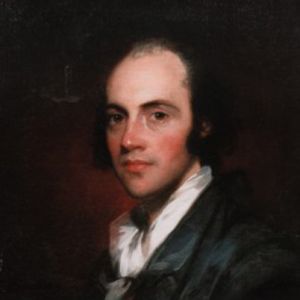
Only one Vice President of the USA ever killed a man while in office. Only one ex-Vice President of the USA was ever tried for treason. Aaron Burr was so divisive a figure that after his vice presidency was ended the rules were changed to ensure that in future the Vice President would be more likely to support the President. He was a war hero, a notorious womanizer and an early exponent of female suffrage, yet now he is more remembered for the life he ended than the life he led.
Aaron Burr was born in 1756 in New Jersey. His father had been the second president of the College of New Jersey (which later became Princeton University), and his maternal grandfather had been its third president. By the time he was two years old, both his father, grandfather and mother were dead of various illnesses, leaving him to be raised by his mother’s brother, Timothy Edwards. Aaron did not get on well with his uncle, and ran away from home several times. On one occasion he had even signed on as a ship’s cabin boy by the time his uncle found him and took him home. As a teenager he studied at the College of New Jersey, naturally, where his classmates included several of the future founding fathers. Originally he studied to be a Calvinist minister as his father had been, but his natural rebellious streak along with the Enlightenment philosophy he absorbed left him ill-suited for that path, and he instead changed to studying law. Less than a year into his studies, however, the American Revolution broke out and Burr went to war.
Burr first served under Colonel Benedict Arnold, on his 300-mile march to invade Quebec. It was a brutal journey with many men turning back or perishing en route. Eleven hundred men set out but only six hundred, Burr among them, arrived at the gates of Quebec. Though Arnold’s men outnumbered the professional garrison four to one, they were supported by a local militia and had the advantage of their fortified position. At first Arnold tried to brazen it out and demanded their surrender, but they refused to rise to the bait. He was forced to pull back and regroup. He sent Burr off to make contact with General Richard Montgomery, commander of the other American force fighting in Canada at the time. Montgomery had just captured Montreal, and immediately came to Arnold’s aid. Burr, who had been promoted to Captain Burr for his successful delivery of the message, fought by Montgomery’s side in the Battle of Quebec.
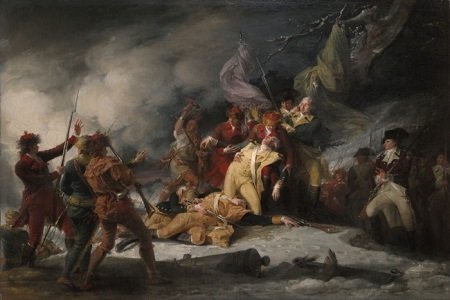
Burr was thus one of those by Montgomery’s side when his attack on the city went disastrously wrong. There was a blizzard in full force at the time, and Montgomery’s forces had broken through the two palisades protecting the city (in fact, the defences being wooden, they had sawed through them). Montgomery led a group of fifty men into the city, but they managed to walk directly into a fortified British position. In the hail of bullets Montgomery and the bulk of his advance force were killed. Burr was one of the survivors and was forced to retreat, though he made enough of a showing to be commended for his courage. Arnold’s attack on the other side of the city was similarly repulsed, leading to the first serious defeat the Continental Army had suffered in the war. Arnold remained for an ultimately futile siege of the city, but Burr was recalled to Manhattan. Here he was given a place on Washington’s staff, but he resigned it two weeks later in order to return to the field. This slight may have turned Washington against him. Burr served under General Israel Putnam, a ferocious military veteran, and was responsible for saving an entire brigade of men from capture by the British after they were nearly cut off from the main force by a British landing. [1] Despite this heroism, Burr failed to receive a commendation from Washington. Whether this was an oversight or a response to his resignation of his staff position, Burr took it as a personal slight and never forgave Washington.
Despite this lack of recognition he was promoted to Lieutenant Colonel, and served in this position for two years. He was at Valley Forge during the long cold winter that the Continental Army endured there, and helped to prevent one of the many mutinies that nearly broke out. In 1779 ill health led him to resign his commission, and he returned to New York to continue studying law. He was not entirely idle in the remainder of the war though, and as well as performing occasional intelligence missions he helped rally the students at Yale together to form a militia and push back a raid by General William Tryon. In 1782 he graduated, and the same year he married a wealthy widow named Theodosia Prevost. Burr was not a faithful husband, in fact he was a notorious womaniser. He had multiple illegitimate children, including two with an East Indian servant named Mary Emmons, which were both born before Theodosia’s death in 1794. Burr had one legitimate child, a daughter also named Theodosia. She was well educated, in accordance with Burr’s belief in equality of the sexes. Sadly she died before her father, perishing during a sea voyage in 1812 when a schooner carrying her was lost at sea.

Burr, like many of his contemporaries, turned to politics after the war. He served on the state assembly from 1784 to 1785, but his main involvement in the political scene came when he was appointed Attorney General in 1789. In 1791 he was elected as a Senator for New York, defeating Philip Schuyler, the incumbent. Schuyler’s daughter was married to a man Burr had shared a legal practice with, Alexander Hamilton. The two men had been on social terms before this, but Burr’s defeat of Schuyler and conduct during the campaign set them at odds, and eventually a deep mutual dislike and distrust would develop between the two. Burr served as state senator for six years, and after he was defeated in 1797 he was immediately elected to the state assembly. In 1796 he had put his name into the Presidential race, aiming for the position of Vice President rather than President. At this time the electors each received two votes that they could cast for any man, and the candidate who came in second became Vice President. Burr had made a vote exchange pact with Thomas Jefferson, but many of Jefferson’s supporters in the developing Republican Party refused to honour the deal and failed to cast their second vote for Burr. As a result, though Jefferson came second (and became Vice President to John Adams), Burr only came fourth.
Over the next four years, the American political establishment began to develop, with the two party system (at this time, the Republicans and the Federalists) solidifying into place. In New York, two poles also started to develop. Alexander Hamilton had been using his contacts in the Society of Cincinnati to help further his political career, and in retaliation Burr took control of the Tammany Society, a local fraternal organisation. The society, known later as Tammany Hall, would continue to dominate and control New York’s politics until the 1960s. With this tight grip on the New York scene, Burr was in a far stronger position going into the election of 1800, and the new party system meant that Jefferson was more able to follow through on his pledge. The agreement was that all the Republican affiliates would vote for Jefferson, and all but one would vote for Burr. Whether through miscommunication or deliberate betrayal on Burr’s part, the man meant to cast only one vote cast two and they wound up tied with 73 votes each, joint first in the election. The decision thus had to be made by the House of Representatives, and Burr wound up allying with the Federalists in an attempt to take the Presidency. He had a powerful enemy in Hamilton however, who had become Burr’s bitter enemy the previous year when he had solicited a government grant with Hamilton’s support to set up a water company, and then used it instead to set up a bank after secretly editing the terms of the grant. The vote turned intensely personal, and both Jefferson and Burr’s reputations were severely sullied. In the end, it took 36 ballots before the matter was eventually decided in Jefferson’s favour.
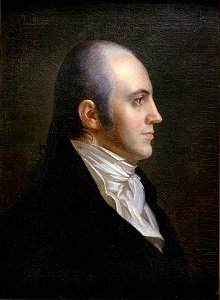
Burr’s enmity with the President made him a singularly ineffective Vice President, and in fact his term was so poor that it led to the rules being changed to cause there to be a totally separate vote for Vice President in future. The most notable feature of his term was his unsuccessful attempted impeachment of a Supreme Court Judge for failing to act impartially, which helped to establish the lack of power of the Executive Branch over the judiciary. Knowing that he stood no chance in the 1804 Presidential election, he instead ran for Governor of New York but lost, owing largely to the smears thrown at him during the 1800 vote being dragged up again. Burr was on the verge of losing all influence, and decided that only a duel could restore his honour. At the time duels were largely bloodless affairs, in which both participants would usually throw away their fire, simply demonstrating their courage. They did, however, sometimes turn deadly, and Alexander Hamilton’s son had been killed in one a few years earlier. This did not prevent Burr provoking Hamilton into a duel, however, through demanding (after suitable escalation) an apology for any remarks Hamilton had ever made defaming his character. Hamilton’s own reputation had suffered severely after an extramarital affair had come to light, and so he had no choice but to accept Burr’s challenge. The stage was set for the most famous duel in American history.
The exact mindset of Burr and Hamilton going into the duel is still a matter of intense debate. On the one hand, Hamilton had become opposed to duels after his son’s death, and had told friends of his intention to shoot to miss. On the other hand, he provided the weapons – hair trigger pistols of a deadlier than usual calibre, with which he was well practised. Burr, on the other hand, was almost certainly out for blood. Hamilton had made an offer before the duel to apologise for any specific insult, but Burr still demanded the general apology. Exactly what happened during the duel, however, is uncertain. As duelling was technically illegal, the two seconds stood in the woods with their backs to the action so they could afterwards swear to have “seen no shots fired”. What they heard, however, was one shot, then a second or so later another. What they returned to find was Burr standing, and Hamilton lying on the ground, mortally wounded.
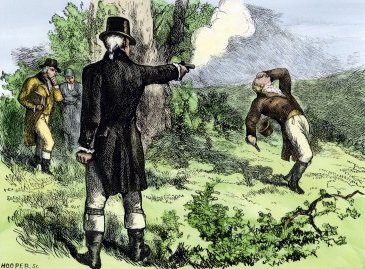
Historians have different opinions on how the duel had gone. The first, and most common, is that Hamilton had fired first, aiming to miss, but not firing into the ground as was common in such a case. Burr, hearing the shot go past his head, had taken it for a miss and shot to kill. Others follow the same sequence, but say that Hamilton’s shot was meant to kill and missed. A third was that Burr fired first, and Hamilton, once hit, tried to return fire before he fell. Whichever of these was true, the result was the same. Hamilton died of his injuries, and Burr’s political career was effectively over. To take part in a duel was one thing – to kill a man in one was another. He was charged with murder in New York and New Jersey but avoided trial until the charges were dropped, heading first to South Carolina to lay low before returning to Washington to serve out his term. His farewell speech as Vice President was his farewell to American politics, and it is said to have moved his harshest critics to tears.
That was not the end of Burr’s impact on American history, however. Like so many who had burned their bridges in the civilised territories, Burr set off west to try to reclaim his destiny. He leased 40,000 acres in Louisiana, at the time in the hands of the Spanish, which he proclaimed his intention to farm. His true intentions, however, were much murkier. The same year, 1805, saw the territory first revert to the French and then be sold to the Americans in the famous “Louisiana Purchase”. Around the same time Burr had a series of meetings with Anthony Merry, the British ambassador to the US, where he offered to split Louisiana off from the Union and make it a British colony. At the same time Burr also met with the Mexican Associates, a group who were trying to raise support to invade Mexico and claim it for the US, and with the Spanish ambassador Carlos Martínez de Irujo. To the latter he declared his intention not only to secede, but to declare war on the US and march on Washington. Finally he recruited the Governor of Louisiana, General James Wilkerson. Burr had been responsible for Wilkerson being appointed Governor, [2] possibly due to Wilkerson having tried to get Kentucky and Tennessee to secede twenty years earlier. This turned out to be a mistake, as Wilkerson forwarded the letters to President Jefferson, and Burr was arrested for treason.
Exactly what Burr’s endgame plan was is hard to say, but one possibility was that he intended to provoke the secession of part of Mexico from Spanish control. This wouldn’t be so far-fetched – thirty years later the Republic of Texas would do exactly that. This would not qualify as treason in the eyes of many Americans, and in fact neither would (at the time) seceding from the Union. Legally, leading a military expedition into Mexico might have qualified, but Burr had been arrested before things had got that far. In fact, he was arrested three times, but the first two times, the judge refused to commit him for trial. The third time he was committed, but unsurprisingly he was acquitted – the matter was sealed when Wilkerson was forced to admit to altering the letters he forwarded to Jefferson to minimise his own guilt.
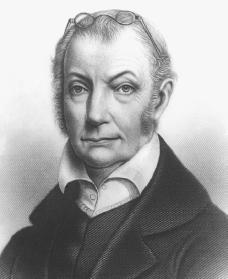
Burr was released, but any political capital he had was thoroughly spent. He travelled to Europe, trying first to gain British support and then French for fomenting a revolution in Mexico. (He also took advantage of the trip to visit dozens of European prostitutes, which he recorded in detail in his memoirs.) Unable to get the support he needed, he returned to America in 1812 – the same year that his daughter died. For a time he used his mother’s surname of Edwards to avoid his creditors, but eventually he was able to return to his own name and his legal practice in New York. There he lived out his days in relative obscurity, adopting two boys (one possibly his own illegitimate child) and even remarrying in 1833, at the age of 77, to a rich widow in her fifties. She divorced him shortly thereafter when she realised he was using her money to speculate on the land market. Three years later, after a long illness, he died. He had played a vital role in the founding of one republic, and nearly caused another to be founded thirty years before its time, but in the end it was as a duellist and killer he would be most remembered. Playing second fiddle to Hamilton, even after death – nothing would have annoyed him more.
[1] Among those he saved was Alexander Hamilton, of whom more later.
[2] Louisiana was not yet a state, and so its governor was appointed rather than elected.
